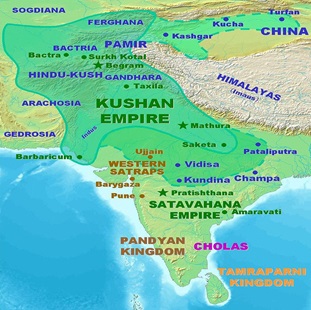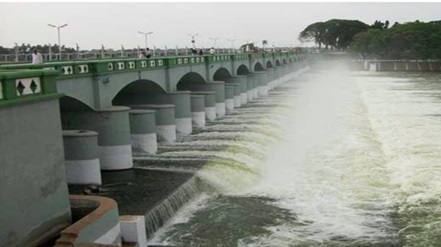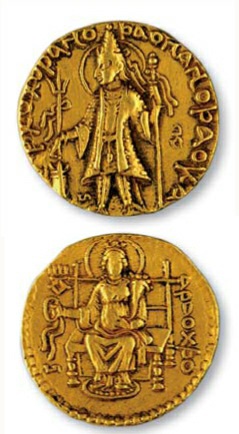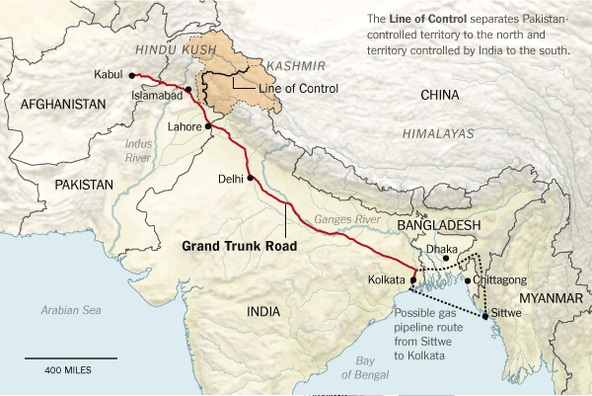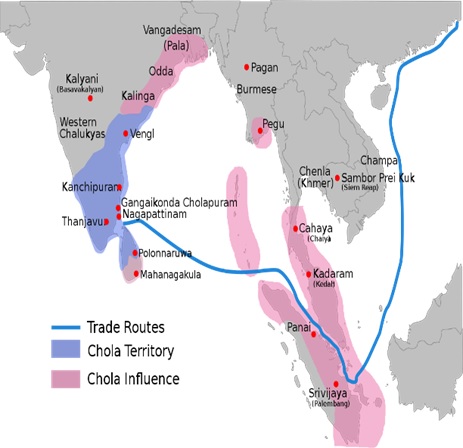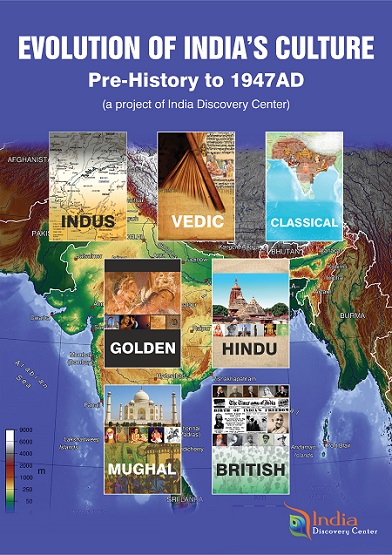India Golden Period (200BCE-500AD) – Economy and Politics
Various kingdoms flourished during this time (Figure 1). A peculiar feature of the strong Satavahana administration was the presence of feudatories of different grades. The empire was marked by urban centers, royal inscriptions, and the issuance of state coins. The kingdom (janapada) was the highest political unit, and was divided into districts (aharas), and then further subdivided into villages (grámas). KhÄravela in Kalinga was a Jain, but tolerant towards all religions. He constructed majestic rest houses for Jaina Sramanas, Brahmanical Rishis, and Buddhist Samghayanas.
Figure 1. Various Kingdoms of India during Golden Period
Magadhas were the first to use elephants on a large scale in wars. The famous Chola king, Karikala, built big irrigation channels along the river Kaveri. Figure 2.
Figure 2. Kallanai dam, originally constructed in 2nd century CE.
MadurÄi was the port and served as the capital of the Pandya kingdom. Korkai served as the trade center. The Pandyas were wealthy and prosperous. The most important element in district administration was the governor (nagaraka) who was responsible for preserving law and order, revenue collection, street cleanliness, maintenance of troops and secret agents, prevention of fire, flood, famine, and plague.
Political system was decentralized into regions and administrative units. Kautilya’s charter (see Classical Period) was followed. Political peace was maintained through economic prosperity. Administration of justice was delegated to the king’s court. The counselor acted as King’s chief legal advisor. Punishment was imposed based on the written law. Judicial standards were set. Judges were free, impartial and honest.
Taxes were collected in moderation. A basic land tax called bhaga (share) was a fixed fraction of the crops produced, the highest being one sixth. Taxes were levied on livestock, dairy produce, pottery and textiles. Trade was taxed by export and import duties. Merchants paid road taxes. A tax officer (Antapala) collected the taxes.
Kushanas minted large quantities of gold coins (Figure 3) and low value copper coins. Satavahana empire produced coins of silver, copper, lead and potin. Coins of Graeco-Bactrians which circulated around north of Hindu Kush were made of gold, copper, silver, and nickel. Many coins were produced by non-monarchical states of Arjunayanas, Uddehikas, Malavas, and Yaudheyas. Figure 2 shows copper coins of Yaudheyas, Ayodhya, and the Kunidas.
Figure 3. Gold coins used during the reign of Kanishka II.
Figure 4. Copper coins of Yaudheyas, Ayodhya, and Kunidas
There were number of ‘city coins’ produced by many cities such as Tripuri, Varanasi, Taxila, Ujjayini etc.
Agriculture was the main occupation. Co-operative irrigation was practiced. Cattle were used for plowing fields. Crops and vegetables cultivated included: Rice, pulses, pepper, saffron, gourds, pumpkins, sugarcane. Land was distributed among individual holdings and was divided into cultivated lands for fruit groves, sugarcane plantations, grazing. New towns sprang near the coast, like in the Godavari delta, or in ports of Broach, Cochin. Road network of ‘Grand Trunk Road’ (Figure 5) played a vital role in trading activities.
Figure 5. Grand Trunk Road 200CE.
Several inscriptions across India points towards the existence of many guilds by artisans such as wood workers, painters, leather workers etc. They had relationship with Kings and were working in ordinance with the kingdom. There is evidence of guilds acting as banks. People invested money and got the interest back from guilds.
The markets of Puhar and Madurai were trading flowers, garland, aromatic powders, bangles, garments etc. There was huge maritime trade between India and other lands (Figure 6). Apart from traders many others were travelling such as students, professionals, teachers, and entertainers. Trade continued along the routes of Uttarapatha and Dakshinpatha. The economy was stable and the land was prosperous.
Figure 6. Chola marine trade route
Exported items included
Agricultural products: Grains, sugarcane, millets, spices, tamarind. Forest Products– sandalwood, rosewood, teak, medicinal herbs, ivory. Metals – Gold, Silver, Copper. Marine products - pearls, corals, conch shells. Textiles, muslin, bangles
Imported items included
Arabian horses, Chinese porcelain and silk, Roman jars, tortoise shell from Southeast Asia.
References:
1 – A History of Ancient and Early Medieval India till 1200AD – Upinder Singh
2 - The cultural heritage of India, Volume II
- Ramakrishna Mission - Institute of Culture, Calcutta
3 – A Wonder that was India – A. L. Basham 1954
4 – Kautilya – The True Founder of Economics – Balbir Singh Sihag, 2014
Figure acknowledgement:
Figure 2. https://en.wikipedia.org/wiki/Kallanai_Dam
Figure 3 & 4 – Book by Upinder Singh (above)
Figure 5 - Nytimes.com – Grand Trunk Road
--------------------------------------
Mr. Hardik Dixit leads the Economy and Politics track in India Discovery Center's project on "Evolution of Indian Culture: Pre-history to 1947AD". More information and updates on the project are available at https://www.facebook.com/Evolution-of-Indian-Culture-An-IDC-Project-107749391111922
(c) Copyright 2021 India Discovery Center, Inc. All rights reserved.
